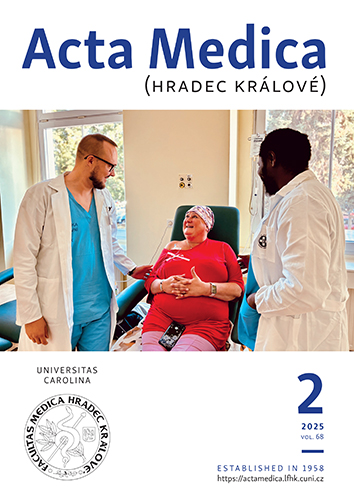ACTA MEDICA, Vol 63 No 2 (2020), 79–81
Duodenal Pressure Necrosis in a Child Caused by a Migrated Percutaneous Endoscopic Gastrostomy
Jan Melek, Markéta Štanclová, Radek Štichhauer, Pavel Rozsíval, Jan Kopřiva, Jana Dědková, Eva Terifajova, Eva Šedivá, Petr Dědek, Sylva Skálová, Jan Bureš
DOI: https://doi.org/10.14712/18059694.2020.21
published online: 10. 08. 2020
abstract
A two-year-old girl with two weeks of abdominal pain, vomiting, and food refusal, ten months after percutaneous endoscopic gastrostomy insertion because of inadequate peroral intake, was admitted to a tertiary centre hospital. On admission, the extracorporeal part of the gastrostomy was much shortened. X-ray examination revealed migration of the end of the gastrostomy tube with a left-shifted course of the tube through the duodenum. Gastroscopy and subsequently laparotomy were performed. A longitudinal pressure necrosis was identified under the tube, with two perforations in the duodenojejunal region. Ten centimeters of that duodenojejunal region were resected, and end-to-end anastomosis was made. The migration of the gastrostomy was probably caused by insufficient care by the parents. Pathophysiologically, the tube caused the pressure necrosis in the duodenojejunal area; this was supported by histology. This is a hitherto undescribed complication of a percutaneous endoscopic gastrostomy, showing that migration of the gastrostomy to the deeper part of the small bowel can lead to pressure necrosis, a potentially life-threatening condition in children which cannot be treated without invasive procedures.
keywords: children; migration; percutaneous endoscopic gastrostomy; perforation; pressure necrosis

Duodenal Pressure Necrosis in a Child Caused by a Migrated Percutaneous Endoscopic Gastrostomy is licensed under a Creative Commons Attribution 4.0 International License.
210 x 297 mm
periodicity: 4 x per year
print price: 150 czk
ISSN: 1211-4286
E-ISSN: 1805-9694
